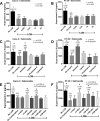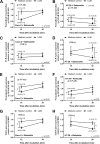Lactobacillus rhamnosus L34 Attenuates Gut Translocation-Induced Bacterial Sepsis in Murine Models of Leaky Gut
- PMID: 29038123
- PMCID: PMC5736799
- DOI: 10.1128/IAI.00700-17
Lactobacillus rhamnosus L34 Attenuates Gut Translocation-Induced Bacterial Sepsis in Murine Models of Leaky Gut
Abstract
Gastrointestinal (GI) bacterial translocation in sepsis is well known, but the role of Lactobacillus species probiotics is still controversial. We evaluated the therapeutic effects of Lactobacillus rhamnosus L34 in a new sepsis model of oral administration of pathogenic bacteria with GI leakage induced by either an antibiotic cocktail (ATB) and/or dextran sulfate sodium (DSS). GI leakage with ATB, DSS, and DSS plus ATB (DSS+ATB) was demonstrated by fluorescein isothiocyanate (FITC)-dextran translocation to the circulation. The administration of pathogenic bacteria, either Klebsiella pneumoniae or Salmonella enterica serovar Typhimurium, enhanced translocation. Bacteremia was demonstrated within 24 h in 50 to 88% of mice with GI leakage plus the administration of pathogenic bacteria but not with GI leakage induction alone or bacterial gavage alone. Salmonella bacteremia was found in only 16 to 29% and 0% of mice with Salmonella and Klebsiella administrations, respectively. Klebsiella bacteremia was demonstrated in 25 to 33% and 10 to 16% of mice with Klebsiella and Salmonella administrations, respectively. Lactobacillus rhamnosus L34 attenuated GI leakage in these models, as shown by the reductions of FITC-dextran gut translocation, serum interleukin-6 (IL-6) levels, bacteremia, and sepsis mortality. The reduction in the amount of fecal Salmonella bacteria with Lactobacillus treatment was demonstrated. In addition, an anti-inflammatory effect of the conditioned medium from Lactobacillus rhamnosus L34 was also demonstrated by the attenuation of cytokine production in colonic epithelial cells in vitro In conclusion, Lactobacillus rhamnosus L34 attenuated the severity of symptoms in a murine sepsis model induced by GI leakage and the administration of pathogenic bacteria.
Keywords: Lactobacillus rhamnosus L34; antibiotics; dextran sulfate solution; gastrointestinal leakage; murine model.
Copyright © 2017 American Society for Microbiology.
Figures










References
-
- Singer M, Deutschman CS, Seymour CW, Shankar-Hari M, Annane D, Bauer M, Bellomo R, Bernard GR, Chiche JD, Coopersmith CM, Hotchkiss RS, Levy MM, Marshall JC, Martin GS, Opal SM, Rubenfeld GD, van der Poll T, Vincent JL, Angus DC. 2016. The third international consensus definitions for sepsis and septic shock (Sepsis-3). JAMA 315:801–810. doi:10.1001/jama.2016.0287. - DOI - PMC - PubMed
-
- Leelahavanichkul A, Panpetch W, Worasilchai N, Somparn P, Chancharoenthana W, Nilgate S, Finkelman M, Chindamporn A, Tumwasorn S. 2016. Evaluation of gastrointestinal leakage using serum (1→3)-beta-d-glucan in a Clostridium difficile murine model. FEMS Microbiol Lett 363:fnw204. doi:10.1093/femsle/fnw204. - DOI - PubMed
-
- Leelahavanichkul A, Worasilchai N, Wannalerdsakun S, Jutivorakool K, Somparn P, Issara-Amphorn J, Tachaboon S, Srisawat N, Finkelman M, Chindamporn A. 2016. Gastrointestinal leakage detected by serum (1→3)-beta-d-glucan in mouse models and a pilot study in patients with sepsis. Shock 46:506–518. doi:10.1097/SHK.0000000000000645. - DOI - PubMed
Publication types
MeSH terms
Substances
LinkOut - more resources
Full Text Sources
Other Literature Sources
Medical
Molecular Biology Databases

